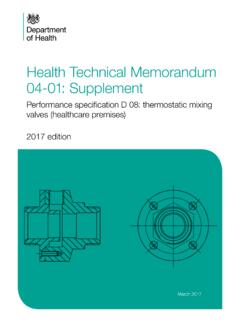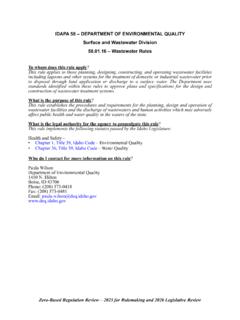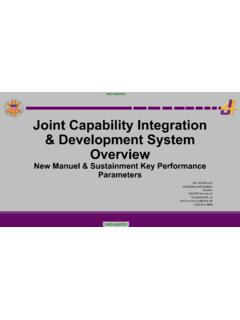Transcription of Guideline on Water Treatment Systems Dialysis Water and …
1 1 Guideline on Water Treatment Systems , Dialysis Water and Dialysis fluid quality for haemodialysis and related therapies Clinical Practice Guideline Prepared on behalf of The Renal Association1 and The Association of Renal Technologists2 January 2016 Review Date January 2020 All feedback to NicholasHoenich1,2, Clinical Scientist, Newcastle University Robert Mactier1, Consultant Nephrologist, NHS Greater Glasgow & Clyde Ian Morgan2, Principal Renal Technologist, King s College Hospital NHS Foundation Trust Gerard Boyle2, Senior Renal Technologist, Dumfries and Galloway Royal Infirmary David Croft2 Paul Rylance1, Consultant Nephrologist, Royal Wolverhampton Hospitals NHS Trust and Lead for the Renal Association British Renal Society Patient Safety Clive Thompson, Visiting Professor, Wolfson Center for Materials Processing, Brunel University, London, and Chief Scientist, Alcontrol Laboratories, Rotherham 2 Endorsements Conflict of Interest Statement Nicholas A Hoenich No conflict of interest Robert Mactier No conflict of interest Ian Morgan No conflict of interest Gerard Boyle No conflict of interest David Croft No conflict of interest Paul Rylance No conflict of interest Clive Thompson Employee of Alcontrol Laboratories.
2 Who perform a wide range of microbiological and chemical analysis for all Water types. 3 Contents Introduction Summary of clinical practice Guideline on Water Treatment Systems , Dialysis Water and Dialysis fluid quality for haemodialysis and related therapies 1. Clinical governance of Water Treatment Systems for haemodialysis (Guidelines ) 2. Planning and commissioning of Water Treatment Systems for haemodialysis (Guidelines ) 3. Installation and validation of Water Treatment Systems for haemodialysis( Guideline ) 4. Operation and maintenance of Water Treatment Systems for haemodialysis (Guidelines ) 5. Monitoring the quality of Dialysis Water for haemodialysis and Dialysis fluids ( ) 6.
3 Water Treatment Systems for the Treatment of acute kidney injury (Guidelines ) 7. Water Treatment Systems for home haemodialysis (Guidelines ) 8. Haemodialysis concentrate production and distribution Systems (Guidelines ) Rationale of clinical practice Guideline on Water Treatment Systems , Dialysis Water and Dialysis fluid quality for haemodialysis and related therapies 1. Clinical governance of Water Treatment Systems for haemodialysis (Guidelines ) 2. Planning and commissioning of Water Treatment Systems for haemodialysis (Guidelines ) 3. Installation and validation of Water Treatment Systems for haemodialysis ( Guideline ) 4. Operation and maintenance of Water Treatment Systems for haemodialysis (Guidelines ) 5.
4 Monitoring the quality of Dialysis Water for haemodialysis and Dialysis fluids (Guidelines ) 6. Water Treatment Systems for the Treatment of acute kidney injury (Guidelines ) 4 7. Water Treatment Systems for home haemodialysis (Guidelines ) 8. Haemodialysis concentrate production and distribution Systems (Guidelines ) 5 Introduction Water of the appropriate quality used in the preparation of Dialysis fluid is an essential requirement of haemodialysis and related therapies. International standards have been developed to promote the installation of fit for purpose Water Treatment Systems for haemodialysis and to safeguard the routine production of Dialysis Water suitable for use for haemodialysis and haemodiafiltration.
5 Quality requirements for the Water and concentrates used to prepare Dialysis fluid, and for Dialysis fluid, are provided in a series of standards issued by the British Standards Institute . (1-5) [ BS EN ISO 13959; 2015: Water for haemodialysis and related therapies, BS EN ISO 13958:2015: Concentrates for haemodialysis and related therapies, and BS EN ISO 11663: 2015:Quality of Dialysis fluid for haemodialysis and related therapies. BS EN ISO 26722: 2015: Water Treatment equipment for haemodialysis and related therapies and BS EN ISO 23500: 2015: Guidance for the preparation and quality management of fluids for haemodialysis ]. Copies of the Standards may be purchased at the BSI Online Shop at can be accessed via subscription to British Standards Online (BSOL) at The rationale for the development of these standards is to protect haemodialysis patients from adverse effects arising from known chemical and microbiological contaminants found in Water and improperly prepared Dialysis fluid.
6 In spite of the availability of standards, there have been instances of failure to achieve the requirements outlined in the standards, particularly in new build renal units where the responsibility for the Water Treatment plant operation and monitoring lies outside NHS remit and is provided either by external contractors under a private finance initiative (PFI) or by an equivalent scheme. Under these schemes, responsibility for the delivery of infrastructure and services (such as maintenance) required to provide a public service is transferred to a third party in the private sector. The recommendations in this Guideline have been graded using the modified GRADE system whenever appropriate 6,7.
7 In addition for clarity and consistency the terminology used in this Guideline has been standardised with the BS EN ISO standards as follows: shall means that compliance with a requirement or a test is mandatory; should means that compliance with a requirement or a test is recommended but is not mandatory for compliance; and may is used to describe a permissible way to achieve compliance with a requirement or test. feed Water is used throughout this Guideline to mean Water supplied to a Water Treatment system or an individual component of a Water Treatment system . Synonyms such as raw Water , source Water , supply Water or potable Water may be used instead of feed Water . product Water is used throughout this Guideline to mean Water produced by a Water Treatment system or an individual component of a Water Treatment system .
8 Synonyms such as permeate, treated Water , purified Water or reverse osmosis Water may be used instead of product Water . However this does not specify any limits, and consequently the International Standards introduce the term Dialysis Water . Dialysis Water is used throughout this Guideline to mean Water that has been treated to meet the specified limits for chemical and microbial contaminants in BS ISO 13959;2015 and is suitable for use in haemodialysis applications, which include the preparation of Dialysis fluid, reprocessing of dialysers, preparation of concentrates and preparation of substitution fluid for online convective therapies. Dialysis fluid is used throughout this Guideline to mean the fluid made from Dialysis Water and concentrates that is delivered to the dialyser by the Dialysis fluid delivery system .
9 Synonyms such as dialysate or Dialysis solution may be used in place of Dialysis fluid. 6 This Guideline incorporates and updates the section on Water quality and Water Treatment for haemodialysis in the haemodialysis module of the 5th edition of the Renal Association Clinical Practice Guidelines (8). The guidance has been harmonised with the previous Guideline on this topic from the European Renal Association whenever possible (9) and also links with guidance from the Department of health on the requirements for Water supplies to healthcare facilities (10,11). The Guideline , in addition to Water and Dialysis fluid quality also addresses environmental and sustainability aspects. Furthermore, since the last revision of these guidelines there has been increased awareness of the need to risk assess Water storage and distribution Systems to prevent or control hazardous substances including biological agents such as legionella.
10 Guidance on legal obligations can be found in the health and Safety Executive publication HSG274 Part 2 & 3 (12, 13) as well as in BS8554:2015 Code of practice for the sampling and monitoring of hot and cold Water services in buildings. (14) Since the Water is used for the preparation of Dialysis fluid, the new version of the Guideline also contains recommendations for the specification and operation of haemodialysis concentrate production and distribution Systems . The primary aim of this Guideline is to assist the entire multidisciplinary team involved in the provision of safe Water Treatment for haemodialysis by providing a single, user friendly document for the routine delivery of fit for purpose Dialysis Water and Dialysis fluid, which has been peer reviewed and approved by the membership of the Association of Renal Technologists and Renal Association and other stakeholders.



